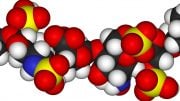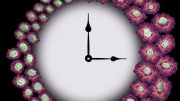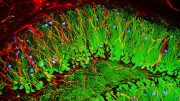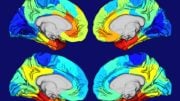
Scientists have conducted a comprehensive study on the interactions between ApoE, a protein involved in cholesterol transport, and heparan sulfate, a cell surface sugar molecule, both linked to Alzheimer’s disease. Their findings, focusing on the importance of a specific modification of heparan sulfate, point to a potential drug target for slowing the disease’s progression: enzymes known as heparan sulfate 3-O transferases. Credit: Dylan Mah
Chunyu Wang, Ph.D., professor of biological sciences at Rensselaer Polytechnic Institute, has added to his body of research on Alzheimer’s disease with his latest findings recently published in the journal Angewandte Chemie.
Together with his team, which includes first author and Rensselaer doctoral student Dylan Mah, Wang conducted the most in-depth analysis to date of the relationship between Apolipoprotein E (ApoE) and heparan sulfate (HS). ApoE is a protein that binds with fats to facilitate the transportation of cholesterol throughout the body, whereas heparan sulfate is a sugar molecule located on cell surfaces, crucial for cellular communication. A variant of ApoE, ApoE4, is the most significant genetic risk for late-onset Alzheimer’s disease.

Chunyu Wang. Credit: Rensselaer Polytechnic Institute
“It’s tremendously interesting to explore why ApoE4 can increase Alzheimer’s risk,” said Wang.
Wang’s team investigated not only ApoE4, but ApoE3, the most common ApoE genotype and two protective isoforms ApoE2 and ApoE Christchurch, as well. They discovered that the 3-O-sulfo (3-O-S) modification of HS was important for ApoE/HS interactions. All isoforms of ApoE recognized 3-O-S, but the differences in their strength of interactions correlated with Alzheimer’s disease risk.
“In the initial glycan array experiment, which is basically a chip with a collection of different heparan sulfate oligosaccharides on it, we flowed ApoE over it,” said Mah. “We were quite surprised to see that it had a binding pattern that looked very similar to Tau protein. It binds very well to the 3-O sulfated structures.”
Tau protein is implicated in many neurogenerative diseases, including Alzheimer’s.
The team’s findings point to a new potential drug target to slow the progress of the disease: the enzymes responsible for sulfation called heparan sulfate 3-O transferases.
Next, the team plans to take a deeper look at ApoE/HS interaction by developing a 3D structural model of ApoE-HS interaction and examining this interaction in cell cultures and animal models.
“Alzheimer’s disease is very complex with so many aspects,” said Wang. “The more I study it, the more interesting it gets.”
“Ultimately, we want to prevent or mitigate enough of the symptoms of Alzheimer’s disease so people can continue to live independently,” added Mah. “Understanding how the disease works on a molecular basis is really critical to finding new treatments.”
“As our population ages, Dr. Wang’s research on Alzheimer’s disease is increasingly significant,” said Deepak Vashishth, director of Rensselaer’s Shirley Ann Jackson, Ph.D. Center for Biotechnology and Interdisciplinary Studies, of which Wang is a member. “The identification of a new potential drug target to fight this progressive disease is enormously exciting for not only the six million patients in the United States but also for their families and caregivers.”
Reference: “Apolipoprotein E Recognizes Alzheimer’s Disease Associated 3-O Sulfation of Heparan Sulfate” by Dylan Mah, Dr. Yanan Zhu, Dr. Guowei Su, Prof. Jing Zhao, Dr. Ashely Canning, Dr. James Gibson, Dr. Xuehong Song, Dr. Eduardo Stancanelli, Dr. Yongmei Xu, Prof. Fuming Zhang, Prof. Robert J. Linhardt, Prof. Jian Liu, Lianchun Wang and Prof. Chunyu Wang, 4 April 2023, Angewandte Chemie International Edition.
DOI: 10.1002/anie.202212636
Wang and Mah were joined in research by Rensselaer Polytechnic Institute’s Ashely Canning, James Gibson, Fuming Zhang, and Robert J. Linhardt. Yongmei Xu, Xuehong Song, and Lianchun Wang of the University of South Florida contributed, along with Guowei Su and Jian Liu of Glycan Therapeutics; Jing Zhao of China Agricultural University; and Yongmei Xu, Eduardo Stancanelli, and Jian Liu of University of North Carolina at Chapel Hill.









Be the first to comment on "New Potential Drug Target for Alzheimer’s Disease Discovered"